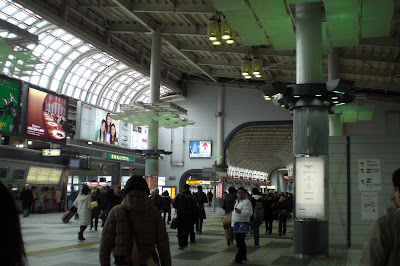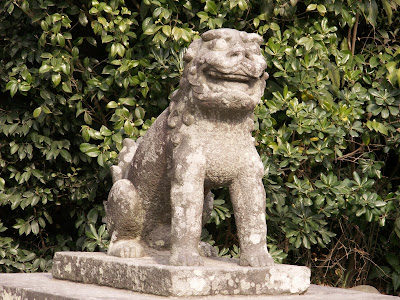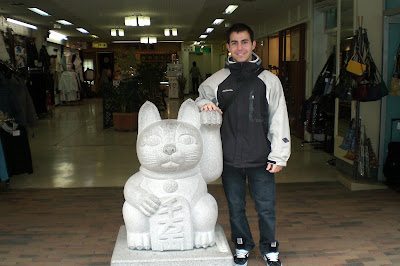The train station leaving from Shinagawa...

And the main walkway in the middle of main street in Kamakura...

It is sometimes considered a former de facto capital of Japan, as the seat of the Regent and Shogunate during the Kamakura Period. According to The Institute for Research on World-Systems,[1] Kamakura was the 4th largest city in the world in 1250 A.D., with 200,000 people, and Japan's largest, eclipsing Kyoto by 1200 A.D.
And, like most major temples, the city has been conveniently built up around it....
As of December 1, 2005, the city has an estimated population of 171,241 and a density of 4,324.27 persons per km². The total area is 39.60 km².
Kamakura was designated as a city on November 3, 1939.
I couldn't tell if this statue was there just because they think cats are good...or just delicious...
Surrounded by mountains on three sides and the open water of Sagami Bay on the fourth, Kamakura is a natural fortress. During the Heian period it was the chief city of the Kantō region, and from the 12th through 14th centuries the Minamoto shoguns ruled Japan from here under what is known as the Kamakura Shogunate.
...and shops. Main street is lined with hundreds of them...
Like ones where you can buy sweet Japan letterman's jackets...
...or a Karate Kid headband...
...there are even stores where the Crypts from South Central L.A. can pick up the latest in kimono designs...
...and, of course, great food like this Tendon ("Ten" describing the food, tempura shrimp, pumpkin and asparagus over rice, and "Don" meaning bowl)...

Kamakura is now mainly known for its temples and shrines.
Kōtoku-in, with the monumental outdoor bronze statue of Amida Buddha, is the most famous of these. A 15th Century tsunami destroyed the temple that once housed the Great Buddha, but the statue survived and has remained outdoors ever since.







Magnificent Zen temples like Kencho-ji and Engaku-ji; the Tokei-ji (a nunnery that was a refuge for women who wanted to divorce their husbands); the Tsurugaoka Hachiman Shrine; the Hase-dera, an ancient Kannon temple; the graves of Minamoto no Yoritomo and Hōjō Masako; and the Kamakura-gu where Prince Morinaga was executed, top the list of Kamakura's most famous historical and religious sites.
At the entrance to every temple and shrine is a place to cleanse your hands and mouth...



And most have a prayer wall where you can dedicate special messages to those in your heart and mind...




It makes for a great day trip...
...complete with stereotypically beautiful Japanese women...

I'll leave it on a good note...







No comments:
Post a Comment